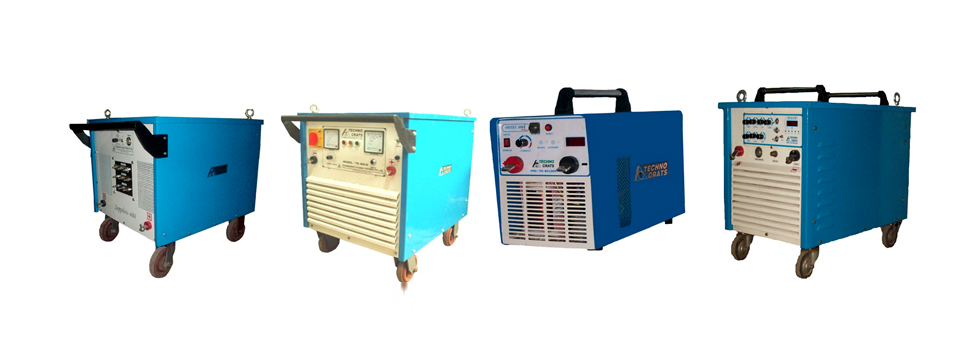Welding Machines

Metal Welding is a fabrication process to join two metal pieces of same or different type by causing coalescence. Welding is generally done by melting the work pieces with heat & sometimes pressure, and introducing a filler metal to create a weld pool. After cooling, this weld pool becomes a strong joint.
Arc Welding is a type of welding that uses a welding power source to create an electric arc between the electrode and the base material to melt the metals at the welding point. They can use either Direct (DC) or Alternating current (AC) and consumable or non-consumable electrodes. The welding region is covered with some shielding gas or some slag.
The best known welding methods are –
Shielded Metal Arc Welding (SMAW) / Manual Metal Arc (MMA) / Tungsten Inert Gas (TIG) / Gas Tungsten Arc Welding (GTAW)
MMA process use drooping characteristic power source and consumable electrodes which produces arc by scratching the electrode with the job forming a short circuit. It is only when the short circuit is broken, arc is formed and the main welding current starts flowing. Welding takes place as the electrode gets fused with the job under the cover of the slag. In case of TIG, arc starts between tungsten electrode (non-consumable) and the job under the cover of inert gas. Arc is started by scratching the tungsten electrode with the job or using a high frequency unit which initiates the arc between the tungsten electrode and the job.
MIG/MAG/CO2 Welding
Gas Metal Arc Welding (GMAW), sometimes referred to by its subtypes Metal Inert Gas (MIG) Welding or Metal Active Gas (MAG) Welding, is a Welding process in which an electric arc is formed between a consumable wire electrode and the work piece metal, which heats the work piece metal, causing them to melt and join. Along with the wire electrode, a shielding gas is fed through the welding gun, which shields the process from the contaminants in the air. The process can be semi-automatic or automatic. A constant voltage, direct current, power source is most commonly used with GMAW, but constant current systems as well as alternating current can be used. There are four primary methods of metal transfer in GMAW, called globular, short circuiting, spray and pulsed spray each of which has distinct properties and corresponding advantages and limitations. It is a faster and economical welding process. Almost all metals can be welded with this process Argon, Argon+CO2 or only CO2 is used as shielding gas depending upon the metals to be welded. Inert gas(Argon) is used for Aluminium, SS etc. Active Gas CO2 or mixture of Argon+ CO2 is used for mild steel welding. Sometimes flexed cored wires are used.
Submerged Arc Welding
Submerged Arc Welding (SAW) is a common arc Welding process. It requires a continuously fed consumable solid or tubular (flux cored) electrode. Molten weld and the arc zone are protected from atmospheric contamination by being “submerged” under a blanket of granular fusible flux consisting of lime, silica, manganese oxide, calcium fluoride and other compounds. When molten, the flex becomes conductive and provides a current path between electrode and the job. The thick layer of flux completely covers the molten metal thus preventing spatter and sparks as well as suppressing the intense ultraviolet radiation and fumes that are a part of the SMAW process.
SAW is normally operated in the automatic or mechanized mode, however, semi-automatic (hand held) SAW guns with pressurized or gravity flux feed delivery are available. The process is normally limited to flat or horizontal fillet welding positions. Deposition rates approaching 45kg/hour is possible with this process. This requires constant voltage power source.
Arc Welding Machine
News & Updates

Catch Latest News & Updates.
News & Updatestestimonials

What Our Clients Says.
Client SpeaksENQUIRE NOW

Enquire About Our Products.
Product Enquirypopular links
Newsletter
Subscribe to our weekly Newsletter and stay tuned.